Buzz Blog
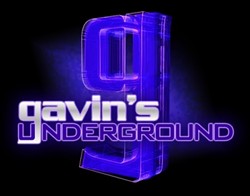
When
it comes to crafts and prints, the two forms rarely intersect. The
idea of one being on a much bigger scale than the other, for an
artist to take their works and fit them to both is a challenge not
many pull off. But today we have one who has successfully make that
move.
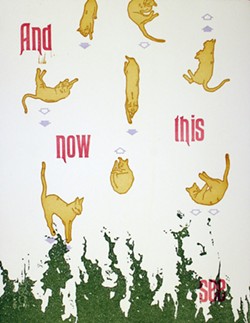
--- Claire Taylor's animal
designs caught the eye of many throughout her art career, and were a
major focus on last year's Craft Lake City. Simplistic in design
while still capturing the imagination of the designs within, Taylor
took her works to a craft level, pushing t-shirts, buttons and even
shrink-y-dinks
out as a new way to enjoy her art. I got a chance to chat with Claire
about her career and the projects she's working on, along with her
thoughts on the art community.
Claire
Taylor
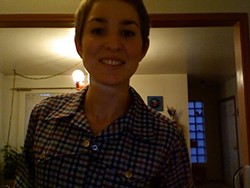
http://www.puppystar.etsy.com
Gavin:
Hey Claire! First off, tell us a bit about yourself.
Claire:
I was born on July 31st, 1984, in Davis, California. Davis is a
small college town near Sacramento, where everyone bikes everywhere.
My family moved to Provo when I was four, where we didn't fit in very
well. I grew up Mormon, but became inactive in high school. Most all
of my immediate family is not Mormon now. I moved to Salt Lake for
college. I like cats and dogs a lot. My boyfriend and I often go for
walks and find cats to pet. I love to exercise. It's sort of a form
of meditation for me. I like to bike and run. I don't own a car and I
don't like public transport very much, but I own two bikes and two
legs, so most all of my transportation is by my own mobility.
Luckily, my day job is just a mile away from my apartment, and I live
near grocery stores. I sometimes like to eat very spicy food, such as
eating wasabi by itself, or habaneros by themselves. I really like
fruit, especially berries. My current favorite drink is vodka tonic,
thanks to my friends Amber Heaton and Laura Decker. I like to read.
Some of my favorite books are the Hitchhiker's Guide To The Galaxy trilogy. I'm interested in cosmology (the study of the cosmos)
and studies of animal intelligence. I also like to listen to radio
news. I like 80's music, and 50's sunglasses. I like to dance. And,
of course I'm fond of drawing and printmaking.
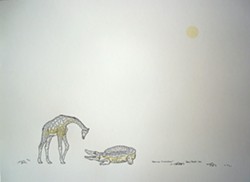
Gavin:
What first got you into art, and what were some of your early
inspirations?
Claire:
I always liked science, math, and animals. In high school most of my
artwork was of my family, my pets and cosmological or microscopic
forms. I come from a large, artistic, alternative sort of family.
Being creative was always encouraged. When I was little I used to
build spaceships out of refrigerator boxes for my younger brother and
I, while my older brother played space age music by David Bowie.
Growing up, all of my family took to creative outlets. My younger
brother, Orson, would create fantastic spaceships and robots out of
Legos from a young age. My older sister, Camilla, was always a good
artist, in the traditional sense. My other sister, Katherine, was an
actress and a dancer in high school, and as an adult takes to
creating things through knitting. My older brother, Blue, is a good
artist, as well, a writer, and a prevalent rock climber (a creative
sport in my opinion). My oldest brother, Josh, drew when young, and
now writes, and has always taken to creative sports such as rock
climbing, aikido, kayaking, etc. My mother has always been intensely
creative in several ways. She paints, is an excellent, creative cook,
knits, sews creations from no patterns, and makes furniture into
sculpture. She's also been an alternative sort of therapist for most
of her career life. Together, my family supported a creative
environment, which nurtured my artistic interests.
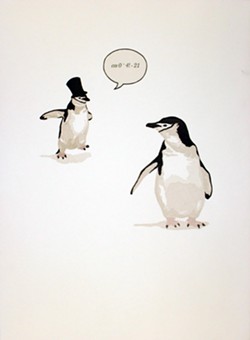
Gavin:
You got your BFA up at the U a few years ago. Why did you choose the
U, and how was their program for you up there?
Claire:
I was one of two runners up for the State Sterling Scholar in art.
Because of this I was offered a half scholarship from Westminster,
and I considered going there. But, I didn't know much about their art
program. Also, since my parents divorce, my family was poor and the U
was more affordable. My older sister Camilla was already in
the art program at the U, so I went there. Not a very exciting
story. Perhaps I should have pursued and looked into other things
more. But, I do think going to the U was a good thing. University of
Utah's print program was good for me. The print instructor, Justin
Diggle, is good at challenging students. He's also well informed in
all the forms of printmaking. In addition to learning printing
methods and techniques, we were somewhat informed on what was going
on around the nation in printmaking. We'd go on yearly trips to the
Southern Graphics Council print conference which is hosted by various
universities throughout the nation, making us able to learn other
printmaking techniques and meet printmakers from around the nation.
The U's print program is also a close community of friends. Everyone
was friends and would go out for drinks together, even
the instructor. Marnie Powers-Torrey was the instructor for
letterpress, she has a very excitable and supportive style of
teaching. She keeps a somewhat relaxed relationship with her students
in her classes, while still pushing them artistically in the
course.
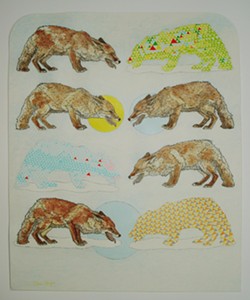
Gavin:
How exactly did you get into print works?
Claire:
I had started college by majoring in art, but left it after a
semester. The pretentious side of art bothered me. My job at the time
was tutoring kids in reading, so I changed my major to elementary
education. I also considered majoring in math. I had taken the AP
Calculus test in high school and received a 5 (which I am extremely
proud of.) I didn't need to take any math classes at the U for my
degree, but I did anyway, out of interest in the subject. But, after
a semester without art classes I found that I missed it. The next
semester, I took a letterpress class for fun from Marnie
Powers-Torrey. I realized what I had been missing by not taking art
classes. I was going to major in painting and drawing. However, I was
very impressionable at the time (no pun intended) and Marnie
Powers-Torrey convinced me that I was a printmaker and should major
in printmaking. Which I did. And I'm glad I did. But, I would like to
take some painting classes sometime.
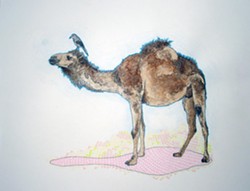
Gavin:
The majority of your work centers around animals. How exactly did
they come about as your muse?
Claire:
All my life I've always loved animals. They have a sort of mystery
and magic about them. I think animals are much more intellectual than
most people give them credit for. Right now I'm reading a book called Why Cats Paint by Heather Busch & Burton Silver. I think cat
painting is just one small example of other animal creative
intelligence. There have been times in my life where I felt as though
I related more to animals than to humans. When going to friend's
houses, I'd often spend more time with their pets than with my
friends, themselves. I used to pet strange dogs I'd find around town
when I was young. I'd do this for even mad looking dogs. But I don't
do that all the time anymore because I have been bitten a couple
times. I sound like a crazy person, I know. The pet I've been most
close to is my dog, Solomon, a whippet. We got him as a puppy. He
looked like a tiger-giraffe. He was very smart, frisky and
territorial. For a few years, most of my artwork was of him. We had
to put him asleep a couple years ago. It was very sad, but he was
really old. He had health problems, as he was addicted to chocolate
(which is really bad for dogs). He'd steal all the chocolate he could
get, no matter how hard we had made it to get to (he was very
athletic, and could jump really high). It caused him liver
problems.

Gavin:
How do you go about choosing a subject for the pieces you do, and
what's the process like for you when creating a particular
piece?
Claire:
I go through periods of being interested in a certain kind of
animal. I am usually drawn to dog-like animals such as foxes and
coyotes. I look through picture books looking for a photograph of an
animal that strikes my interest. Usually it is not the type of animal
that perks my interest, but the intelligence and personality
portrayed in the image of the animal. When I'm drawing I work
spontaneously, and usually do not plan out the picture. I generally
start with a picture of an animal and then draw things around the
animal, reacting to what I've already drawn. I think working in this
way can make “happy accidents.” I think it also helps to open up
my mind and allow things from my subconscious to naturally occur in
the picture. When drawing, I mainly like to work with graphite,
colored pencil and watercolor. Because of the process, printmaking
isn't as easy to work spontaneously. Because of choice, and the
facilities available to me, I now only make prints that are made
through some sort of relief process. Relief printing is printing from
a raised surface which is inked, and then pressed onto paper. All of
my prints start out as a drawing of an animal. I then need to
transfer that image onto a matrix to be printed from. I often use
lino. I will transfer my image to a lino block and carve the lino.
I'll usually make my lino images with the two block/reductive
process. I will have one block, which will be my key block, and
transfer the image I've carved on the key block onto a second block,
which will generally be a reductive block. Reductive in relief
printmaking terms means that you print the block initially in one
color, then carve away more of the material, and print it again in a
different color, and carve away more again, and print it again, etc.
Generally I print an animal onto the paper first, and then react to
that when adding other elements to the print. In this process I'll
try to figure out what the print needs to create an environment or
narrative around the animal. In addition to lino, I like to use
photopolymer plates exposed with negatives from scribe coat film to
make my relief prints. Scribe coat film is no longer made, but used
to be used in map making. It's a plastic sheet with a thin layer of a
colored material on one side of the plastic. The colored material can
be scratched into creating clear areas surrounded by the color. In
this way, I can draw onto the scribe coat film and make a negative
image. I then use the negative to expose the image onto photopolymer
film, with UV light. The photopolymer plate can then be mounted to a
steel base to make it type high and be ready to be printed on the
letterpress.
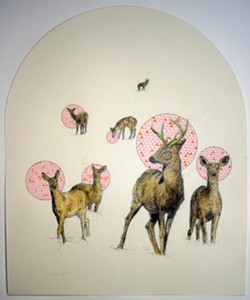
Gavin:
When did you start doing solo shows, and what was it like to start
hearing reactions to your art?
Claire:
I've only actually had one show which could be considered a solo
show. It was small, and not in a gallery, but in display cases at the
Marriott Library. It was called “King Pirate Dog Broadsides” and
it showed in the cases on the first floor.
Probably the most exciting show for me that I've done was a show at
Kayo. It was a three person show in July 2009. I made a lot of new
work for that show. Hearing reactions to my art is exhilarating for
me. It's a wonderful feeling when someone else is excited about your
artwork, especially if it's a piece that I am excited about, myself.
Because my artwork is an extension of myself, when someone likes it,
it feels like an approval for my own character.
Gavin:
What made you start participating in group showings, and how is it
for you being one of many for a particular show?
Claire:
Printmaking lends itself well to group shows. Because most forms of
printmaking easily makes multiples, print exchanges and shows of
these exchanges are common. I started participating in group shows
when I started printmaking. Being one of many for a particular show
is like an exhibition of the community mentality surrounding
printmaking. Many of my friends are printmakers, and we will often
print together and participate in shows together. I think of painting
and drawing as more of a solo form of working. While printmaking can
of course be done solo, it is more of a communal way of working than
painting and drawing.
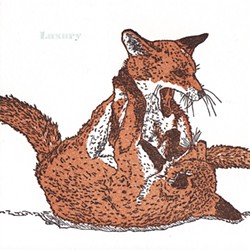
Gavin:
Unlike a lot of other artists, you don't just stick to one medium.
You've incorporated them into t-shirts, accessories like badges and
necklaces, even shrink-y-dinks. What made you take your work in that
direction?
Claire:
I get bored with doing the same thing for a long time. I have to
switch things up occasionally. Plus, making crafty things is fun! I
like the fact that things like t-shirts and badges and shink-y-dinks,
etc. make you part of the art by wearing it. These pieces can be
shared more readily and are more accessible than a traditional piece
of artwork. I made up a holiday, Moxy Mosos Day, which occurs
quadrennially: January 27th, April 27th, July 27th, and October 27th.
The holiday centers around jumping and drinking tea. It's based on a
story of my dog, Solomon, visiting the gray-brown rabbit clan, and
the celebration that ensued upon his arrival. One July I had a joint
Moxy Mosos Day party and birthday party. I printed and glued felt
Moxy Mosos badges for everyone to wear at the party. Everyone wore
their badges, making everyone part of a community of that holiday and
the artwork relating to it. Some of my friends still wear these
badges occasionally, as do I.
Gavin:
This past year you were part of Craft Lake City. How was that event
for you and being a part of that collective of artists?
Claire:
Craft Lake City was a really fun event. Since it was a craft fair,
it was more family based than a regular gallery. It exposed a
different group of people to artwork, who might not normally be. SLUG
had an awesome group of artist's participating in the event, and it
was an honor to be a part of that group.
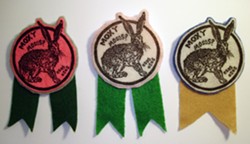
Gavin:
You also work for the Book Arts Program at the U. How did you get
involved with that, and what's it been like for you doing that
job?
Claire:
I started working at the Book Arts Program about six years ago as a
work study student part-time. Back then, just Madelyn Garrett, Marnie
Power-Torrey and Jen Sorensen (of The Rookery)
were working there. It's grown a lot since then. It's been kind of
interesting being a part of the transformation of the program, and
acting in several parts of it. I was offered a full time job at the
program three years ago. After a year I switched to %uFFFD time, so
that I would have time to work on my artwork. I like working at the
program. My co-workers are amazing people, and fellow artists. Some
of my best friends work at the program. Plus the job offers me a lot
of freedom. But, I must say the main draw for working at the program
is because I have access to this wonderful facility and equipment. We
have several letterpresses, and a guillotine, and board shears,
amongst a few other jewels.
Gavin:
Looking at the local picture, what are your thoughts on our art
scene, both good and bad?
Claire:
Because Salt Lake City's downtown is somewhat small, the local art
scene is a fairly close-knit community. Everyone knows each other,
and is very supportive of each other. While this does make some
“schools” of artistic styles, if you will, we still have a wide
breadth of different artistic styles and mediums going on
locally.

Gavin:
Is there anything you believe could be done to make it more
prominent?
Claire:
Well, the old answer of downtown growing. More local businesses.
Local businesses integrating with the galleries, or acting as
galleries and business themselves, but supporting each other. It is
happening with places like Frosty Darling and Kayo, and the Bayleaf
Cafe, Ken Sanders, Sam Wellers, etc. But, I think more integration
between local businesses and galleries/artists would be good.
Gavin:
While we're on the topic, what do you think of the galleries we have
here in Utah?
Claire:
I can mainly only speak of the galleries I've been to in Salt Lake
and Utah County. I think we have a good variety of galleries, meeting
different aesthetic tastes. The local galleries are very supportive
of local art, rather than non-local art.

Gavin:
With you dabbling in crafts, what is your take on Craft Sabbath and
the work they've been doing recently?
Claire:
I'm not very familiar with Craft Sabbath. I've only gone to it once.
So, I'm not able to have an informed opinion.
Gavin:
What can we expect from you throughout the year?
Claire:
Right now I'm working on some pieces for a group show at GARFO in
February. GARFO is at the old Garfield Elementary School, and run by
Cara Despain and Kenny Riches. I'll be part of the Round 6 member
show at Kayo in February, as well. I'll be part of a group print
show/exchange, “Liminal,” which my older sister Camilla
is organizing. That will show at Kayo in March. I'll also have an
image to be printed on tall-boy beer cozies at Copper Palate Press on
the March Gallery Stroll, along with several other print artists.
I'll be participating in the Alternative Press Fair at the downtown
library in July. That's all I have planned thus far for 2010, but
probably more stuff will come up. Hopefully I'll be able to soon get
a solo/small group show, again, but I need to start applying to
galleries. So far I've played things by ear and just participated in
things when I've been asked to. Very few shows I've done because I
actively asked to be in them. Being asked to participate in things is
definitely a good thing, but it does have one drawback. I have a hard
time saying no to things, because I feel it's good to participate in
these shows, but it makes it hard to focus on one particular thing
I'd like to do.
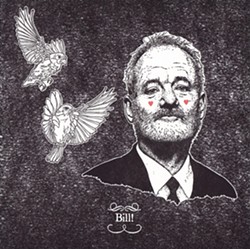
Gavin:
Is there anything you'd like to promote or plug?
Claire:
I'd like to urge people to come to the relatively new GARFO gallery.
All the artwork that's shown there has been stellar. They've
consistently had local boundary pushing shows there since they
opened. Also, check out Copper Palate Press. They're located behind
the old Guthrie building downtown. They are a co-operative printshop,
and also hold gallery shows with the monthly gallery stroll.
Saltgrass is another good co-operative printshop, located in Sugar
House. For listings of the Book Arts Program's 2010 workshops, look
at our website. I also have an Etsy store. I don't have much on it right now, but do
check it out! And, thanks, Gavin!